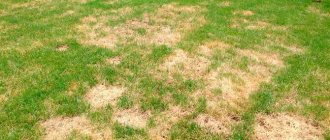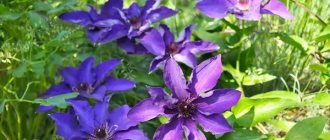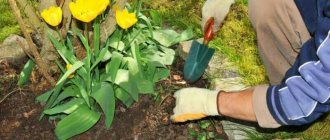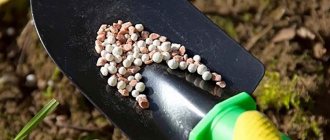To get a good raspberry harvest, you will need to provide the crop with proper care in the spring after winter.
Dear readers!
For you, we have created communities on social networks in which useful articles and interesting ideas are published several times a day! Subscribe and receive useful content in a convenient format! With the onset of the new summer season, plants need pruning, fertilizing, watering and treatment for diseases and pests. And these activities must be carried out according to a certain scheme.
In today’s article we’ll talk about how to properly care for berries.
When to start caring for raspberries in spring?
You should start caring for raspberries immediately after winter, when the temperature reaches above zero. But it is important to carry out most of the activities before the buds begin to swell. This happens in mid-spring, and depends on the climate of the region:
- Crimea, Kuban . You should start caring for raspberries after winter in late March - early April.
- Central strip, Moscow region . Events should be carried out in mid-spring (early to mid-April).
- Northern regions . You should start caring for raspberries no earlier than the end of April.
ATTENTION! In any region, immediately after winter, even before the snow melts, it is necessary to remove all the debris that has accumulated between the rows. Collected plant residues should be burned, as they may harbor pests and pathogens.
When to remove cover after winter
Caring for raspberries in the spring after winter begins with removing the cover.
You can remove the cover from raspberry bushes in the beginning - mid-March or in April, when the air temperature during the day reaches +2...+8 °C during the day, and at night does not drop below 0 °C.
At this time it is worth exposing the soil. Then it will warm up faster, and the roots of the plants will receive additional nutrition.
Spring pruning of raspberries after winter
You can start pruning raspberries in spring when the temperature reaches above zero and the soil dries out slightly. But the event should be completed before the plant’s growing season begins.
In spring, it is necessary to carry out sanitary pruning of the crop. In the process, it is necessary to remove damaged, broken shoots. It is necessary to cut out young shoots, twisted and deformed branches. Healthy stems should be shortened by 20 cm. Shoots frozen in winter should be cut back to the first living bud.
How to feed raspberries in spring
Feeding is an important part of plant care. Fertilizers should be applied after winter immediately after the snow melts.
For spring feeding, you need to use preparations with nitrogen (ammonium nitrate or urea). In every sq. m of planting, it is enough to add 10 g of fertilizer.
To prevent fertilizers from deoxidizing the soil, it is necessary to combine them with wood ash (200 ml for each plant).
REFERENCE! Instead of mineral fertilizers, you can use organic matter. A solution of manure (1:10), bird droppings (1:20) is suitable.
When is the first time to water raspberries in the spring?
Raspberries do not tolerate stagnation of moisture at the roots, and for the first time after winter they do not need watering. You will need to irrigate the soil when the soil dries sufficiently and the crop buds open.
So, in the southern regions, the planting should be watered for the first time in late April - early May. In the north, this event should be postponed until the end of spring.
Treatment of raspberries in early spring from diseases and pests
When caring for a plant after winter, you need to treat it against diseases and pests.
This event should be carried out in early spring, before the buds of the crop bloom. In the process, it is necessary to use copper-containing preparations (copper sulfate, Bordeaux mixture), which prevent the development of fungal diseases and rot.
2-3 weeks after the first treatment, before the crop blooms, you need to spray the plants with insecticides (Aktellik, Fufanon-Nova, Vermitek). Biofungicides such as Fitoverma and Aktofit are also suitable.
REFERENCE! To increase the effectiveness of treatments, tank mixtures consisting of several insecticides and fungicides can be prepared. But it is important to select drugs that are compatible with each other and work under similar conditions.
Protection from harmful insects and diseases
The main diseases affecting raspberry bushes:
- anthracnose;
- rust;
- white spot
Parasites that eat this crop include:
- weevil;
- spider mite;
- stem fly;
- raspberry beetle
Spraying and application of insecticides is carried out only after pruning the bush.
Raspberries are treated with the following preparations in the spring:
- "Essence of Fufanon."
- “Fitoverm” and “Agravertin” - 2 times every 10-14 days.
- Nitrophenic solution, eliminating the raspberry beetle.
- Bordeaux mixture.
In order to combat the stem fly, the shoots around the base are covered with mulch.
Important: plants infected with viruses must be immediately removed from the garden, otherwise large areas will become infected. For other diseases, chemotherapy should be used.
Transplanting raspberries in spring
Over time, the raspberries grow, the beds thicken, and the shoots no longer receive enough light. And this negatively affects the quality of the crop and the health of the plants themselves.
To renew the planting, it is worth replanting some bushes of the crop every 4-5 years. This event must be carried out before the buds open.
For transplantation, it is better to choose the early morning of a cool day. You will need to follow these instructions:
- In the prepared area, dig holes with dimensions of 30*30 cm. Maintain a distance of 50-70 cm between them. The distance between rows should reach 150-120 cm.
- Shorten the shoots, leaving stumps 40-60 cm long. Carefully dig up the bush, being careful not to damage the roots.
- After clearing away the old earthen lump with a wooden stick, divide the plant into several parts. Each division should contain at least 2-3 shoots and a sufficient number of roots.
- Place the resulting bushes in the center of the pits. Carefully straighten the roots and sprinkle them with soil. As a result, the root collars should be buried 2-3 cm into the soil.
- Water the planting well, pouring 5-6 liters of water under each specimen. When the moisture is absorbed, add more soil and irrigate again.
- Mulch the surface of the bed with a 5-centimeter layer of straw, peat or rotted sawdust.
REFERENCE! At the bottom of the planting holes it is worth laying a layer of sawdust, rotten boards, and rotten branches. These materials will feed the plants as they decompose.
Pruning in autumn
Raspberries should be pruned approximately 2 or 3 weeks before cold weather. You need to carefully examine all the bushes and determine which branches should be removed and which ones should be left. In the fall, you definitely need to cut off: old shoots that have already bear fruit; diseased branches and those that were susceptible to pest attack; young shoots, broken shoots and those that develop poorly; useless branches, and thicken the raspberry bush.
Important ! You need to cut the shoots closer to the ground, without leaving stumps.
The distance between the bushes should be about 60 cm, no less. If the bush has grown greatly, then the excess shoots need to be cut off with a shovel. Each bush is processed this way. Due to the fact that raspberries grow quite quickly after autumn pruning, no more than 10 shoots should be left per linear meter of plot. By the way, in the fall, remontant raspberries also need to be pruned. Cut branches must be removed from the site and burned.
How and when to tie up raspberries in spring
You need to tie up raspberries after spring pruning and cleaning the area. When growing a crop using a trellis method, you will need to attach the shoots so that they fan out. It is worth maintaining an interval of 10-12 cm between the stems. It is better to tie each of them in 2 places.
When growing raspberries using the bush method, it is necessary to drive stakes between the specimens. The stems should be tied to them. But you need to trim the crop so that each bush consists of a maximum of 6 shoots, and their height does not exceed 150 cm.
Is it possible to give raspberries a hot shower?
A hot shower is a useful activity that should be carried out at the beginning of spring, without waiting for the snow to melt. In the process you will need to follow the algorithm:
- Boil water and pour into a 5 liter watering can.
- Water the raspberry planting with hot water.
- Use 1.5-2.5 liters of water for each bush, depending on their growth. Pour it from a height of 70-100 cm.
REFERENCE! A hot shower will not harm the raspberry when its buds have not yet woken up after winter. But the procedure will destroy pests, including nematodes.
How to prepare the ground for raspberries
You need to prepare a place for raspberries before winter, following these instructions:
- Dig the area to a depth of 25-30 cm.
- In every sq. m of soil, add 10 kg of rotted manure, 60 g of superphosphate, 50 g of potassium sulfate. If the soil is dense, then you need to dilute it with sand (2-4 buckets per 1 sq. m).
- Loosen the soil, but do not level it. This way, in winter, snow will accumulate in clods, and after melting it will saturate the soil with moisture.
In the spring, before planting the plant, dig up the soil again, loosen and level it.
How to care for old bushes in spring?
Over time, raspberry bushes stop producing a rich harvest. And they need to be updated. You will need to start the event immediately after winter, before the start of the growing season. Algorithm of actions:
- Dig up the strongest bush and cut its long root into several parts.
- Plant the cuttings in fertile soil, water and cover with film.
- When warm weather sets in, remove the cover and provide the divisions with normal care.
In the fall, plant rooted cuttings in place of old bushes.
REFERENCE! If there is free space, you can propagate old raspberries by dividing the bush.
Dates for spring procedures
Work begins when a stable temperature of +5°C and above is established:
- immediately after the last snow has melted, pruning is done, the bushes and the soil underneath are cleared of old foliage, and the first fertilizers are applied;
- when the buds begin to bloom, the branches are pruned a second time, after which the ground is loosened, weeded, fertilized and mulched;
- at the moment of flowering, the raspberries are fed again;
- As the soil dries, the bushes are watered abundantly;
- closer to summer, when new shoots appear, the bush is thinned out.
Tricks for caring for raspberries in spring
Instead of chemicals, you can treat raspberries with folk remedies. They act no less effectively, and at the same time do not harm the soil, pollinating insects and the future harvest. Several recipes:
- Ash-soap solution. Dilute ash (300 g) in water (10 l). After 4 hours, strain the mixture and add 40 g of grated laundry soap to it. Treat the bushes with the solution on a windless day to prevent fungal diseases.
- Mustard solution. To repel aphids and other pests from planting, you need to combine 100 g of dry mustard and 10 liters of warm water. Use the solution immediately after preparation.
Summer pruning
Summer pruning is carried out almost after harvest. All branches that bear fruit must be cut down to the base, without leaving stumps. The bush no longer needs them, there is no point in leaving them until autumn and especially until spring, they will hinder the growth of young shoots and shade them.
In order to obtain a rich and high-quality harvest, it is necessary to constantly limit the growth of the raspberry bush in breadth.
Proper pruning of raspberries in summer
If this is ensured, the productive branches located in the center of the bush or strip planting will develop well. Approximately 2-3 times a month, trim all shoots that appear from the ground at a distance of more than 20 cm from the center of the planting. If such manipulations are carried out regularly, they will not take much time.
Common mistakes
Caring for raspberries in the spring after winter is generally quite simple, but due to inexperience, novice gardeners can make a number of mistakes:
- They do not adhere to the work plan and deadlines. For example, if you prune after sap flow, most of the plant will die. Also, do not tie up raspberries before trimming them, as this is impractical.
- During the processing of the beds, the soil is trampled. As a result, raspberry roots receive less air, which reduces yield. To avoid compacting the soil during maintenance, it is worth laying boards or other bedding materials between the rows and walking only on them.
- Do not prune raspberries. If this event is not carried out, the crop will bear fruit worse and become more susceptible to diseases and pests.
- Water the plants too early. Raspberries need to be irrigated when they wake up after winter and their buds open. If you water the crop before this point, its roots may rot.
Answers to frequently asked questions
When caring for raspberries in the spring, gardeners have the following questions:
How much water should I use for irrigation?
At first, it is enough to pour 0.5-1 liters of water under each bush. Gradually, its amount should be increased to 2-3 liters.
How can I replace ammonium nitrate or urea so that the acidity of the soil does not increase?
You can use potassium nitrate. This fertilizer contains a sufficient amount of nitrogen, but after application it does not change the acidity level of the soil.
Watering
Raspberries need regular moisture. During drought, the berries become smaller, dry and completely tasteless.
Transplanted bushes need daily watering until young shoots appear. In the future, in the absence of drought, watering once a week is sufficient.
During flowering and ovary formation, raspberries especially urgently need abundant and regular watering. Ideally, the soil between the bushes should never dry out.
Watering is carried out in furrows, the ground should be saturated with water to 10-15 cm. After watering, the soil is mulched.
In the drier summer period, gardeners use several irrigation options: under the bush, sprinkling, drip. The most reliable and convenient to use is, of course, drip irrigation.
The soil is constantly and evenly moistened, water does not get on the leaves (sunburn, infection development), good savings in water and time spent.











